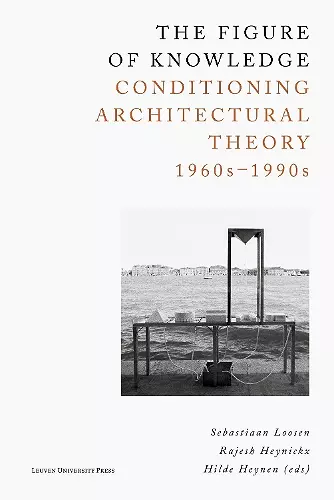The Figure of Knowledge
Conditioning Architectural Theory, 1960s - 1990s
Rajesh Heynickx editor Hilde Heynen editor Sebastiaan Loosen editor
Format:Paperback
Publisher:Leuven University Press
Published:30th Sep '20
Currently unavailable, our supplier has not provided us a restock date

It is a major challenge to write the history of post-WWII architectural theory without boiling it down to a few defining paradigms. An impressive anthologising effort during the 1990s charted architectural theory mostly via the various theoretical frameworks employed, such as critical theory, critical regionalism, deconstructivism, and pragmatism. Yet the intellectual contours of what constitutes architectural theory have been constantly in flux. It is therefore paramount to ask what kind of knowledge has become important in the recent history of architectural theory and how the resulting figure of knowledge sets the conditions for the actual arguments made. The contributions in this volume focus on institutional, geographical, rhetorical, and other conditioning factors. They thus screen the unspoken rules of engagement that postwar architectural theory ascribed to. Contributors: Matthew Allen (University of Toronto), Karen Burns (University of Melbourne), Ole W. Fischer (University of Utah), Philip Goad (University of Melbourne), Hilde Heynen (KU Leuven), Rajesh Heynickx (KU Leuven), Paul Holmquist (Louisiana State University), Sandra Kaji-O'Grady (University of Queensland), Peter Lang (Royal Institute of Art, Stockholm), Andre Loeckx (KU Leuven), Sebastiaan Loosen (KU Leuven), Louis Martin (Universite du Quebec a Montreal), Joan Ockman (University of Pennsylvania), Carmen Popescu (ENSAB, Rennes), Ricardo Ruivo (Architectural Association, London), Andrew Toland (University of Technology Sydney). Free ebook available at OAPEN Library, JSTOR and ProjectMuse
“le livre offre une vision précise et ample, à la fois érudite et accessible, de l’histoire intellectuelle de l’architecture de ces décennies de bascule, dont les années 1960 constituent le point d’orgue, qui virent les architectes partir à la reconquête de leur statut d’intellectuel. […] ‘The Figure of Knowledge: Conditioning Architectural Theory, 1960s-1990s’ montre, si besoin était, qu’il est possible, pour peu d’agir avec méthode, d’écrire l’histoire d’une matière aussi intangible que la pensée architecturale.“
Eléonore Marantz, Critique d’art, URL: http://journals.openedition.org/critiquedart/86655 ; DOI: https://doi.org/10.4000/critiquedart.86655
Combined, 'The Figure of Knowledge' and 'Choosing Architecture' make visible the state of architecture theory today. Even though architecture theory is no longer advanced by polemical manifestos, it remains present in other forms. Either in conversations or design reviews, readings or anthologies, architecture theory continues to reveal and reflect on architecture’s entanglement with historical, societal, cultural and economic concerns. Thinking about architecture remains crucial. - Sergio M. Figueiredo, Archined, 17.05.21, https://www.archined.nl/2021/05/architecture-theory-today-of-theorists-and-theoreticians/
ISBN: 9789462702240
Dimensions: 234mm x 156mm x 17mm
Weight: 495g
321 pages